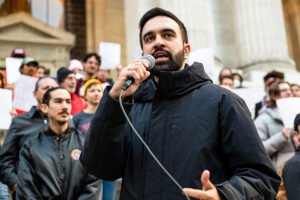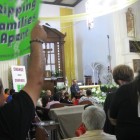Dwarfing the state employee charitable giving campaigns is the federal version—the Combined Federal Campaign (CFC). In the late 1940s and early 1950s, charitable solicitation in federal workplaces was a kind of “uncontrolled free-for-all,” according to the U.S. Office of Personnel Management, with problems such as supervisor- or agency-established quotas for giving or sometimes no charitable solicitation or giving whatsoever.1 When President Eisenhower established the first rules for federal workplace solicitations in 1958, the permitted agencies were service-providers—the predecessors of the United Way, the Community Health Charities, international service agencies, and the Red Cross.
Under President Johnson, the various approved charitable campaigns in federal workplaces were tested as “combined” campaigns, and in 1971 President Nixon established the CFC as the uniform method for charitable solicitations in the federal workplace.
An organization like the American Civil Liberties Union (ACLU), for example, would not have been included in the early CFCs, as participation was restricted to human service, health, and social welfare charities engaged in direct service, excluding advocacy organizations such as legal defense funds. Litigation in the early 1980s such as Natural Resources Defense Council v. Campbell found that the definition of health and welfare charity was too vague. Cornelius v. NAACP Legal Defense and Education Fund2 challenged whether the CFC could establish eligibility requirements on the participation of advocacy groups when the real intent was to conceal a bias against the specific viewpoints expressed by the advocacy groups themselves.
President Reagan entered the fray in the early 80s, issuing executive orders to restrict CFC participation to health and human service groups.3 However, Congress intervened in 1987 under the impetus of Maryland Congressman Steny Hoyer to undo this anti-advocacy restriction and permit the legal defense funds and other nontraditional charities in the CFC. Efforts by the Republican Congress of the mid-1990s to undo the CFC’s openness, led by Florida Republican John Mica,4 didn’t make it to legislation, as the conservatives realized that their attempt to eliminate groups in favor of reproductive rights from the CFC would also have ejected the right-to-life advocates.
Thus, the Combined Charitable Campaign allowed for organizations like the ACLU; other legal defense and litigation advocacy groups; and dozens of social action funds and federations to participate in the federal workplace charitable solicitations, largely protected as a result of Steny Hoyer’s steadfastness on open workplace campaigns. Although participation in the CFC by federal employees dropped from 47.9% in 1993 to 33.9% in the 2003, CFC totals have consistently risen, from $186.9 million in 1989 to over $249 million last year due to the increasing size of contributors’ donations.
Advocacy groups had participated without significant hitches since the mid-1980s—until the advent of the Patriot Act. In late 2003, the Office of Personnel Management (OPM), which directs the CFC, introduced a required certification by CFC charities that they would not “knowingly” employ people whose names appeared on a government anti-terrorism list. The ACLU, like a host of CFC charities, signed off on the language among the dozens of certifications required to get into the campaign (and the ACLU typically gets almost $500,000 from CFC donors annually). Although there are hosts of government lists to check, OPM had promised that only three would be required, and despite the lists’ mercurial inconsistencies from day to day, also promised that it would give advance warning of changes in the list contents.
Nonetheless, the three lists include one that is 143 mind-numbing pages long, containing literally tens of thousands of names plus aliases. Most of the names are transliterations from Arabic and other languages, which cannot be verified. Already, names have appeared on the lists mistakenly, and getting one’s name removed from the lists is a Herculean task. It’s well known that there are enough alternative spellings of names to make certainty regarding employment just about impossible. Who knows whether the CFC anti-terrorism certification might also apply to a nonprofit’s volunteers in addition to their paid employees?
The result? In order to comply—or in order to avoid violating the intent of the policy—many nonprofits are likely to steer clear of anyone whose name might sound like one that would likely appear on these lists, say, any Arabic or Muslim name, for instance.
The impact? Not much would be done to stop terrorism, but innocent people could be denied employment or charities would be denied CFC participation.
Parallels from American history are all too clear. In World War II, Japanese-Americans were herded into internment camps because of the imagined threat they posed as a racial/ethnic group to safety and freedom. All too recently, there is the experience of ex-offenders and people erroneously listed as felons—frequently by virtue of similarly spelled names—being denied their voting rights in the presidential elections of 2000.
Sign up for our free newsletters
Subscribe to NPQ's newsletters to have our top stories delivered directly to your inbox.
By signing up, you agree to our privacy policy and terms of use, and to receive messages from NPQ and our partners.
Not surprisingly, the ACLU rethought its position. After reading press comments from OPM director Mara Patermaster that the CFC certification required charities to affirmatively review and check employment against these lists,5 the ACLU withdrew from the CFC and announced that it would challenge the employment certification standard.6 The ACLU has gathered a coalition of nonprofits to join it in protesting this government requirement that nonprofits police themselves for terrorism suspects. Several have joined the ACLU in leaving the CFC.
Where all of this will lead is hard to tell. It may well be that the language of the Hoyer-Hatfield amendment in the mid-1980s prohibits any OPM policy that would change eligibility standards without express Congressional authorization. It may well be that the vagueness and uncertainty of the government’s terrorism lists makes their use as a threshold for CFC participation unconstitutionally vague. OPM could meet with the affected charities and choose logically to take the burden of substituting for government off the backs of the CFC nonprofits. If under pressure from Treasury or from John Ashcroft’s Justice Department OPM is unwilling to rethink the inappropriateness of its new requirement, all of this might devolve into a new phase of litigation to keep the CFC open to diverse and sometimes nontraditional charities. However it turns out, the ACLU’s action represents a step toward challenging the Bush Administration’s effort to make nonprofits the substitute implementers and guarantors of the government’s anti-terrorism policies.
1. www.opm/gov/cfc/html/cfc_hist.htm.
2. Cornelius v. NAACP Legal Defense & Education Fund, 473 U.S. 788 (1985).
3. Executive Order 12353 (March 23, 1982); https://www.reagan.utexas.edu/resource/speeches/1982/32382f.htm; Executive Order 12404 (February 10, 1983); https://www.reagan.utexas.edu/resource/speeches/1983/21083c.htm.
4. “Congressman Mica Seeks to Strip Some Nonprofits’ Access to Federal Employees’ Payroll Contributions.” Free Speech Newsletter 3(2) June 1995; https://www.freespeechcoalition.org/nwsv3n2.htm.
5. Liptak, Adam. “A.C.L.U. Board Is Split Over Terror Watch Lists.” New York Times (July 31, 2004).
6. Liptak, Adam. “A.C.L.U. to Withdraw from Charity Drive.” New York Times (August 1, 2004).
Rick Cohen is the executive director of the National Committee for Responsive Philanthropy (www.ncrp.org).










